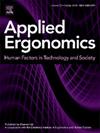The role of different sensory stimuli in an at height simulation
IF 3.4
2区 工程技术
Q2 ENGINEERING, INDUSTRIAL
引用次数: 0
Abstract
A participant's sense of presence in a simulation may be enhanced through the stimulation of additional, non-audiovisual (A/V), senses. However, the impact of these additional stimuli will vary depending on the nature of the scene simulated, the method by which the senses are engaged, and the number of sensory stimuli. No existing studies explore the relative importance of these stimuli on emotions, behaviour and sense of presence in an at height simulation, an application of Virtual Reality (VR) that would enable research and training to be conducted in this application without the associated risk of real at height scenarios.
This paper presents the study of a multimodal simulator to measure 16 participants' physiological, behavioural and self-reported response to an at height simulation. The addition of an unstable plank and ‘wind feel’ (breeze from a fan) to an audiovisual simulator were measured in isolation and combination in a within-subjects, counterbalanced experiment.
Results found the combination of additional cues to yield significant increases to the experienced realism and overall sense of presence experienced by participants according to the igroup Presence Questionnaire (IPQ). The addition of the plank alone resulted in significant increases to fear experienced, feeling of being at height, hesitation and caution. No negative impacts were found because of the additional modalities. Participants’ overall favourite condition was with both the plank and wind feel.
Overall, the results demonstrate a strong case for the use of additional modalities in at height VR experiences.
不同感官刺激在高空模拟中的作用
参与者在模拟中的存在感可以通过刺激额外的非视听(A/V)感官来增强。然而,这些额外刺激的影响将根据模拟场景的性质、感官参与的方法和感官刺激的数量而变化。目前还没有研究探索这些刺激在高空模拟中对情绪、行为和存在感的相对重要性,这是虚拟现实(VR)的一种应用,它可以使研究和培训在这种应用中进行,而不存在真实高空场景的相关风险。本文介绍了一个多模态模拟器的研究,以测量16名参与者对高空模拟的生理、行为和自我报告反应。在一个受试者内部的平衡实验中,在视听模拟器中加入不稳定的木板和“风感”(风扇吹来的风)分别进行了单独和组合测量。结果发现,根据小组存在感问卷(IPQ),额外线索的组合显著增加了参与者体验的现实感和整体存在感。仅增加木板就会显著增加恐惧体验、处于高处的感觉、犹豫和谨慎。没有发现由于额外的方式而产生的负面影响。总的来说,参与者最喜欢的是跳板和风的感觉。总的来说,结果证明了在高空VR体验中使用额外模式的有力案例。
本文章由计算机程序翻译,如有差异,请以英文原文为准。
求助全文
约1分钟内获得全文
求助全文
来源期刊

Applied Ergonomics
工程技术-工程:工业
CiteScore
7.50
自引率
9.40%
发文量
248
审稿时长
53 days
期刊介绍:
Applied Ergonomics is aimed at ergonomists and all those interested in applying ergonomics/human factors in the design, planning and management of technical and social systems at work or leisure. Readership is truly international with subscribers in over 50 countries. Professionals for whom Applied Ergonomics is of interest include: ergonomists, designers, industrial engineers, health and safety specialists, systems engineers, design engineers, organizational psychologists, occupational health specialists and human-computer interaction specialists.
 求助内容:
求助内容: 应助结果提醒方式:
应助结果提醒方式:


